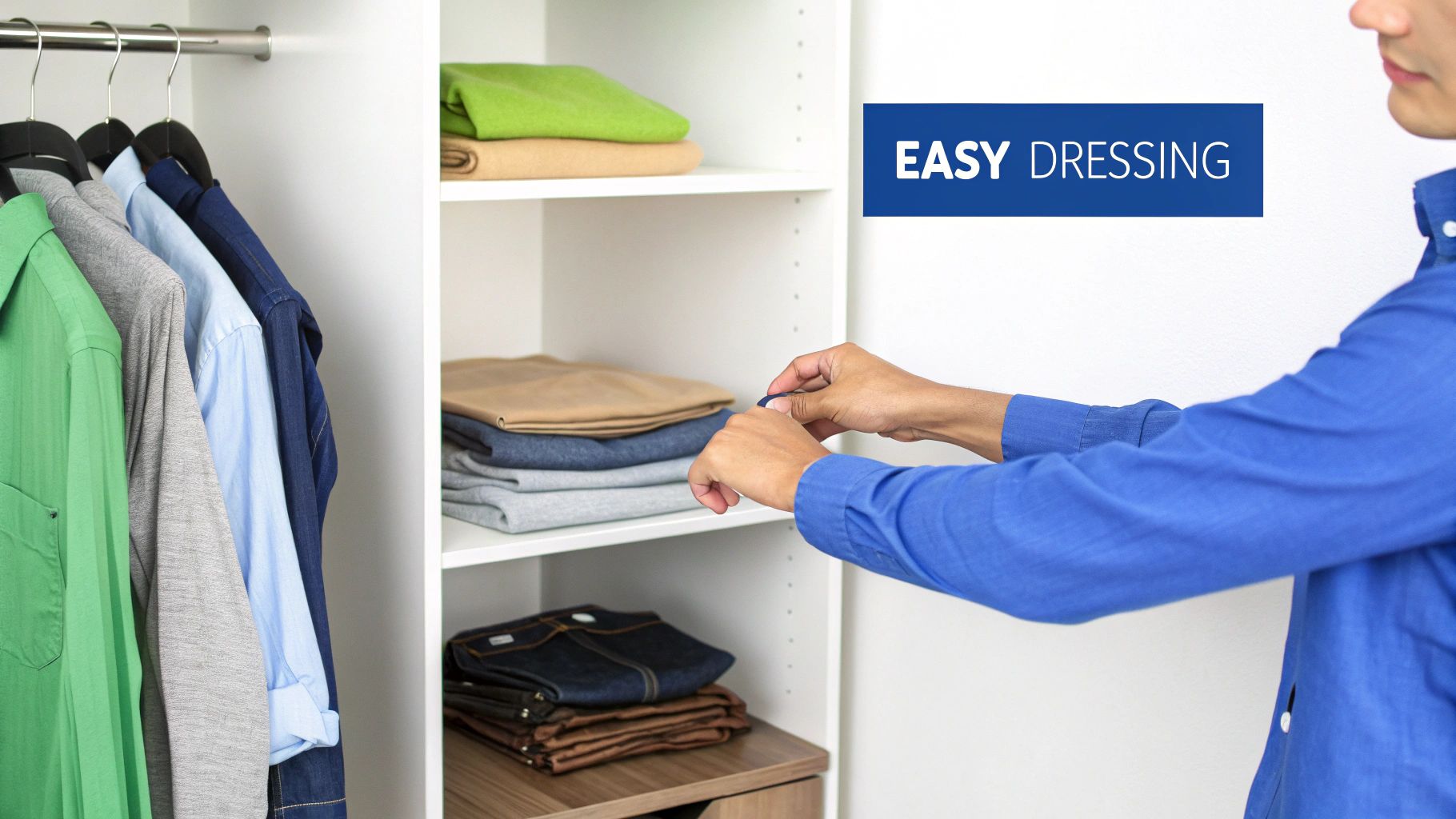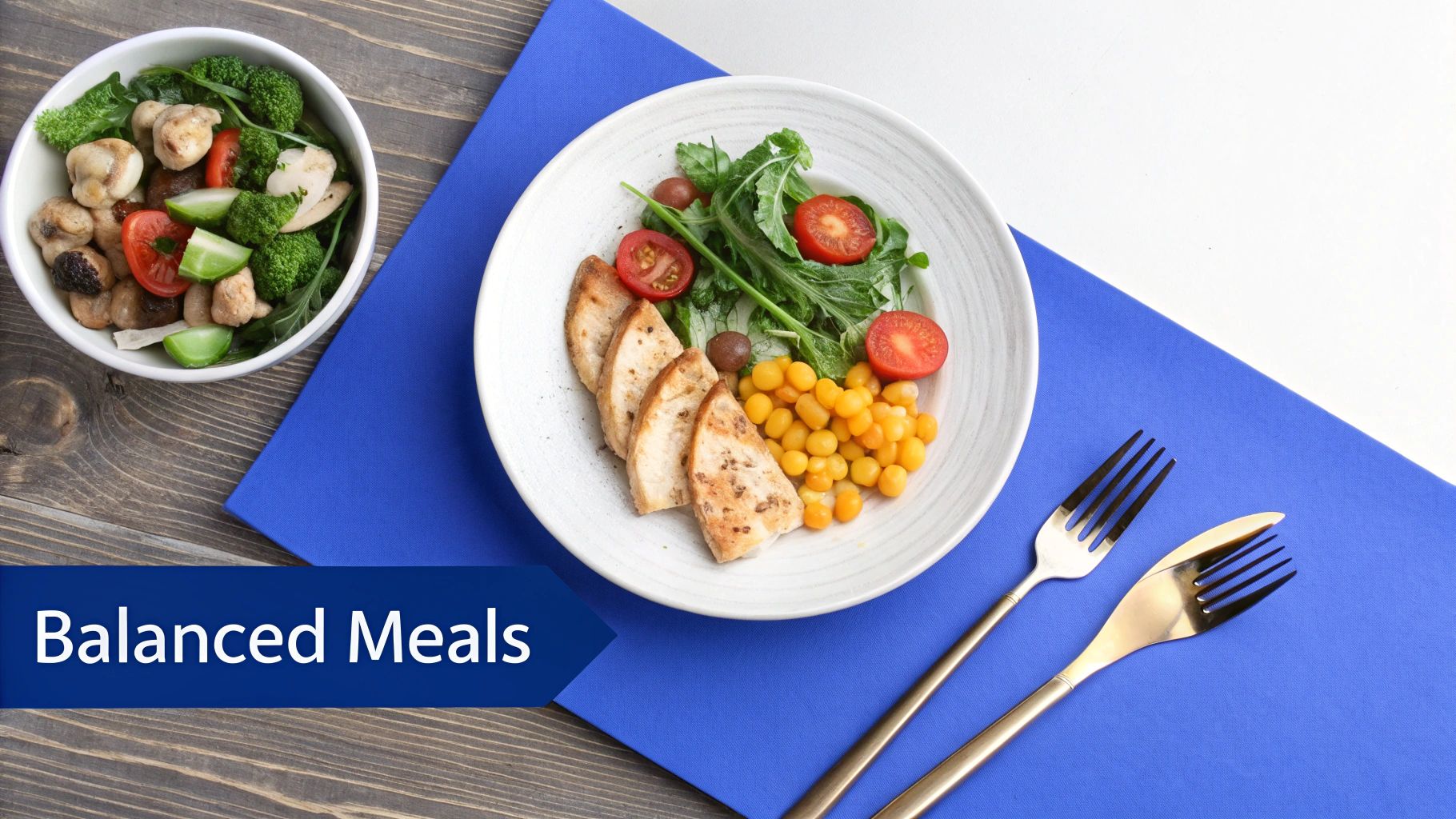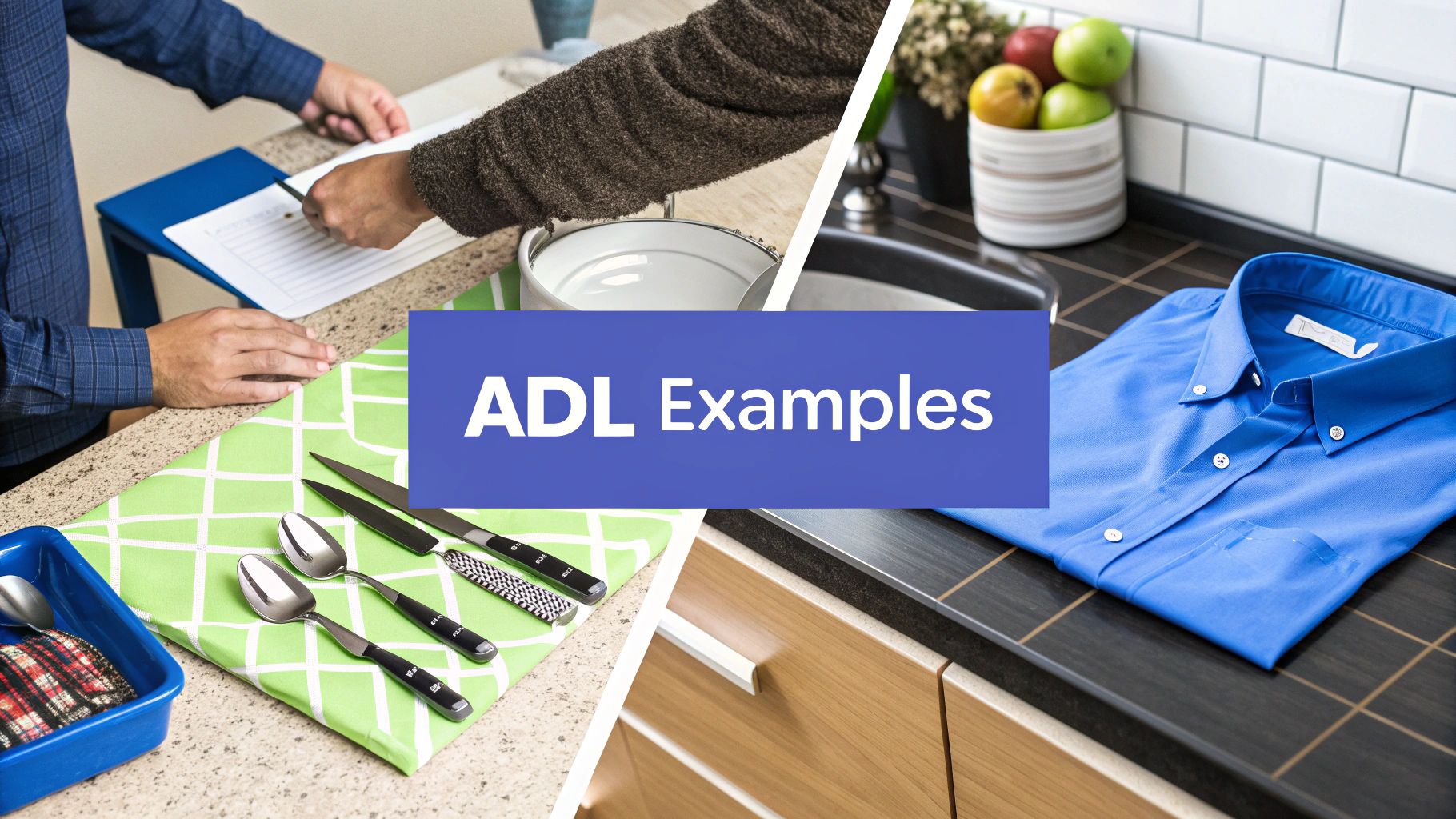Activities of Daily Living, or ADLs, are the essential tasks we perform each day to care for ourselves and manage our lives. They are the fundamental building blocks of personal independence, from the moment we wake up and get dressed to preparing meals and managing our home. A decline in the ability to perform these core functions often signals a need for additional support, making a clear understanding of them crucial for family caregivers, healthcare professionals, and individuals planning for their future.
This comprehensive guide breaks down the most critical activities of daily living examples, offering a deep dive into two main categories:
- Basic ADLs (B-ADLs): These are the fundamental self-care tasks essential for survival, like eating and personal hygiene.
- Instrumental ADLs (I-ADLs): These are the more complex activities required to live independently within a community, such as managing finances or medications.
For each of the eight key examples that follow, we provide a clear definition, analyze real-world scenarios, and present actionable strategies to help maintain, adapt, or support these vital skills. Our goal is to equip you with the specific insights and practical takeaways needed to navigate the challenges of daily living with confidence.
1. Personal Hygiene and Grooming
Personal hygiene and grooming are fundamental activities of daily living (ADLs) that involve maintaining cleanliness and appearance. This core set of tasks includes everything from bathing or showering and oral care to hair and nail maintenance. Performing these routines is not just about looking presentable; it's a critical component of physical health, preventing skin infections, dental problems, and other illnesses while also significantly boosting self-esteem and social confidence.
This ADL is often the first area where individuals, especially aging seniors or those with disabilities, may begin to need assistance. A decline in the ability to manage personal hygiene can be an early indicator that more support is needed. These tasks form the foundation of a person's daily routine and sense of normalcy.
Strategic Breakdown
Managing personal hygiene effectively requires a blend of routine, accessibility, and safety. A consistent schedule helps establish habits, making the tasks feel automatic and less like a chore. For example, a morning routine might always include washing one's face and brushing teeth, while a weekly routine could involve trimming nails. Accessibility is key; having all necessary supplies like soap, shampoo, and toothpaste within easy reach reduces physical strain and frustration.
Key Insight: The goal is to maximize independence while ensuring safety. Adaptive tools can bridge the gap between what an individual wants to do and what they can safely accomplish on their own.
Actionable Takeaways
For family caregivers or individuals seeking to maintain independence, here are some practical tips:
- Establish a Consistent Routine: Set specific times for daily (brushing teeth, washing face) and weekly (bathing, nail care) hygiene tasks to create structure.
- Adapt the Environment: Install safety features like grab bars in the shower, use a shower chair or bench, and place non-slip mats on the floor to prevent falls.
- Utilize Adaptive Tools: Long-handled brushes, electric toothbrushes, and nail clippers with larger grips are excellent activities of daily living examples of tools that can help overcome physical limitations.
- Organize Supplies: Keep all hygiene products in a designated, easily accessible location, such as a shower caddy or a countertop organizer, to simplify the process.
2. Dressing and Clothing Management
Dressing and clothing management is a crucial activity of daily living (ADL) that encompasses the entire process of selecting, putting on, and taking off clothes and accessories. This set of tasks requires a combination of physical dexterity, such as manipulating buttons and zippers, and cognitive abilities, like choosing outfits appropriate for the weather or a specific social setting. Successfully managing this ADL is essential for personal comfort, safety from the elements, and expressing one's identity.

For many individuals, particularly those with arthritis, cognitive decline, or limited mobility, dressing can become a significant daily challenge. A struggle with this ADL can signal a need for greater support, as it directly impacts a person's ability to participate in social activities and maintain a sense of dignity and normalcy.
Strategic Breakdown
Effective dressing management hinges on organization, simplification, and adaptation. Organizing a closet so that frequently worn items are easily accessible reduces both physical and mental effort. Simplifying clothing choices by opting for items with elastic waistbands or magnetic closures can make a world of difference for someone with limited fine motor skills. The process should be broken down into manageable steps to prevent overwhelm.
Key Insight: The primary goal is to empower individuals to dress themselves for as long as possible, which preserves autonomy and personal choice. Adaptive strategies and tools are not signs of failure but smart solutions for overcoming physical barriers.
Actionable Takeaways
For caregivers or individuals looking to simplify the dressing process, consider these practical tips:
- Organize for Accessibility: Arrange clothes by type and season. Place everyday items on shelves or hangers at an easy-to-reach height to minimize bending and stretching.
- Simplify Clothing Choices: Opt for garments with simple fasteners, such as slip-on shoes, pull-on pants, and front-fastening tops. Laying out an entire outfit the night before can also streamline the morning routine.
- Incorporate Dressing Aids: Tools like button hooks, long-handled shoehorns, and zipper pulls are excellent activities of daily living examples of adaptive equipment that can restore independence.
- Ensure a Safe Environment: Provide a sturdy chair or bench to sit on while dressing to reduce the risk of falls. Ensure the area is well-lit and free of clutter.
3. Eating and Nutrition Management
Eating and nutrition management is a crucial activity of daily living (ADL) that goes beyond the simple act of eating. It encompasses the entire process from meal planning and preparation to the physical ability to chew and swallow safely. Maintaining adequate nutrition is essential for overall health, energy levels, and managing chronic conditions, making this ADL a cornerstone of well-being and independence.

This ADL is deeply intertwined with cognitive and physical abilities. For instance, an individual must be able to plan a balanced meal, handle kitchen tools to prepare it, and have the fine motor skills and dexterity to use utensils. Difficulties in any of these areas can lead to malnutrition, dehydration, or choking hazards, highlighting why it's a key indicator of an individual's ability to live safely on their own.
Strategic Breakdown
Effectively managing eating and nutrition involves a three-pronged approach: planning, preparation, and safe consumption. Planning ensures dietary needs are met, especially for those with conditions like diabetes or heart disease. Preparation focuses on making the cooking process safe and manageable, while safe consumption addresses physical challenges like chewing or using utensils. The environment and tools can be modified to support each stage. For example, following diabetic diet guidelines for blood sugar management is a planning task, while using adaptive utensils addresses consumption challenges.
Key Insight: The ultimate goal is to foster a positive and safe relationship with food. This means ensuring that mealtimes are not only nutritious but also enjoyable and dignified, which is vital for mental and emotional health.
Actionable Takeaways
For individuals or caregivers aiming to support independence in eating and nutrition, consider these practical strategies:
- Plan and Prep Ahead: Dedicate time each week to plan meals and pre-portion ingredients. This reduces daily decision fatigue and ensures a balanced diet is always accessible.
- Modify Food and Environment: Cut food into small, manageable pieces to prevent choking and always ensure the individual eats in an upright position to aid swallowing.
- Invest in Adaptive Utensils: Tools like larger-handled cutlery, plate guards, and weighted utensils are excellent activities of daily living examples of aids that help overcome grip strength or coordination issues.
- Create a Pleasant Mealtime Routine: Make meals a positive social experience whenever possible. A calm, unhurried environment can improve appetite and digestion.
4. Toileting and Continence Management
Toileting and continence management refers to the ability to recognize bodily signals, access and use the toilet, manage clothing, and maintain personal hygiene afterward. This fundamental activity of daily living is intensely private, requiring a combination of cognitive awareness, mobility, and fine motor skills. Challenges in this area can lead to significant physical health issues, such as skin breakdown and infections, and can also profoundly impact an individual's dignity and emotional well-being.

The ability to manage toileting independently is a cornerstone of self-sufficiency. A decline in this ADL, whether due to physical limitations like arthritis, cognitive decline from dementia, or post-surgery recovery, often signals a need for environmental modifications or direct personal support. Addressing these needs proactively is crucial for maintaining a safe and sanitary living environment.
Strategic Breakdown
Effective management of toileting centers on safety, accessibility, and routine. Safety modifications in the bathroom are paramount to prevent falls, which are common during transfers on and off the toilet. Accessibility involves not only getting to the bathroom but also being able to use the fixtures without undue strain. For individuals with cognitive impairments, establishing a predictable toileting schedule can help manage continence by creating a routine that bypasses the need for the person to recognize bodily cues on their own.
Key Insight: The primary objective is to preserve dignity and safety by adapting the environment and routine to the individual's specific capabilities. This reduces anxiety and promotes a sense of control.
Actionable Takeaways
For individuals or caregivers looking to enhance independence and safety with this ADL, consider these practical steps:
- Adapt the Environment: Install sturdy grab bars on both sides of the toilet for support during transfers. A raised toilet seat or a toilet frame can significantly reduce the strain on knees and hips.
- Establish a Toileting Schedule: For those with incontinence or memory issues, creating a regular schedule (e.g., every two hours) can prevent accidents and establish a reliable routine.
- Simplify Clothing: Choose clothing with elastic waistbands or Velcro closures instead of complex buttons or zippers to make dressing and undressing easier.
- Organize Hygiene Supplies: Ensure that toilet paper, wipes, and any other necessary cleaning supplies are stored within arm's reach to promote self-hygiene. These are essential activities of daily living examples of how small adjustments make a big difference.
5. Mobility and Transfers
Mobility and transfers are foundational activities of daily living that involve the ability to move and change positions. This includes everything from walking around the home and getting in and out of a bed or chair to navigating stairs or using a wheelchair. The capacity to move freely is essential for engaging in nearly every other daily task and is a cornerstone of maintaining independence and quality of life.
A decline in mobility can significantly impact a person's autonomy, safety, and social engagement. Difficulties with transfers, such as moving from a wheelchair to a toilet, often signal a need for environmental modifications, adaptive equipment, or direct physical assistance. Addressing mobility challenges proactively is crucial for preventing falls and enabling continued participation in meaningful activities.
Strategic Breakdown
Effectively managing mobility and transfers hinges on creating a safe, accessible environment and utilizing proper techniques and tools. The strategy involves identifying specific mobility challenges, such as instability while walking or difficulty lifting one's legs, and implementing targeted solutions. For example, using a transfer board to bridge the gap between a wheelchair and a car seat can empower an individual to leave the house with greater ease and safety.
Key Insight: The primary goal is to foster confident and safe movement. This is achieved by reducing environmental hazards and introducing supportive aids that compensate for physical limitations, thereby preserving independence.
Actionable Takeaways
For individuals or caregivers looking to enhance safety and independence in mobility, consider these practical tips:
- Create Clear Pathways: Remove clutter, secure loose rugs, and arrange furniture to create unobstructed walkways throughout the home, minimizing trip-and-fall risks.
- Use Proper Transfer Techniques: Learn and use correct body mechanics to prevent injury. Always move slowly and deliberately, ensuring a stable footing before initiating a transfer.
- Install Safety Modifications: Add grab bars near the toilet and in hallways, consider a stair lift for multi-level homes, and use hospital beds with adjustable heights for easier transfers.
- Get Professional Fittings: Ensure mobility aids like walkers, canes, or wheelchairs are properly fitted by a physical or occupational therapist. An ill-fitting device can be one of the most overlooked yet critical activities of daily living examples of a safety hazard.
6. Medication Management
Medication management is a critical instrumental activity of daily living (IADL) that involves the entire process of handling prescriptions. This includes organizing and taking medications correctly, monitoring for side effects, refilling prescriptions on time, and communicating effectively with healthcare providers. Proper management is essential for treating chronic conditions, preventing health complications, and ensuring medications work as intended.
This complex task requires significant cognitive function, including memory, organization, and problem-solving. A decline in the ability to manage medications safely is often a clear sign that an individual needs more support. For many seniors and those with chronic illnesses, mastering this daily routine is a cornerstone of maintaining health and independence at home.
Strategic Breakdown
Effective medication management hinges on organization, consistency, and clear communication. A systematic approach, such as using a weekly pill organizer, transforms a potentially confusing task into a simple, structured routine. Setting alarms or using reminder apps creates consistency, ensuring doses are not missed. Perhaps most importantly, maintaining an accurate and up-to-date medication list is crucial for every interaction with healthcare professionals to prevent dangerous drug interactions.
Key Insight: The primary goal is to create a foolproof system that minimizes the risk of error. The right tools and routines can empower an individual to manage their health safely, bridging the gap between medical instructions and daily execution.
Actionable Takeaways
For individuals or caregivers aiming to improve medication safety and adherence, here are some practical steps:
- Use a Pill Organizer: Sort medications by day and time of day (morning, noon, evening, bedtime) once a week to prevent confusion and double-dosing.
- Create a Master Medication List: Keep a detailed, updated list of all medications, including dosages, frequencies, and the prescribing doctor. Bring this list to every medical appointment.
- Set Consistent Reminders: Use a phone alarm, a dedicated reminder app, or even a simple kitchen timer to establish a consistent schedule for taking medications.
- Implement Safe Storage: Store all medications in a cool, dry place away from direct sunlight and out of reach of children and pets to maintain their effectiveness and safety. These are crucial activities of daily living examples of how environment impacts health management.
7. Financial Management and Communication
Financial management and communication are considered instrumental activities of daily living (IADLs), which are more complex tasks essential for living independently within a community. This category includes managing personal finances like paying bills, budgeting, and using banking services, as well as handling various forms of communication such as phone calls, mail, and digital messages. Mastery over these skills is vital for self-sufficiency, security, and maintaining crucial social connections.
Difficulty with these IADLs often signals a need for more support, as challenges can lead to serious consequences like missed payments, financial exploitation, or social isolation. For many seniors or individuals with cognitive changes, tasks like navigating online banking or filtering spam emails can become overwhelming, making this an important area for assessment and assistance.
Strategic Breakdown
Effectively managing finances and communication requires organization, security awareness, and appropriate delegation. A proactive approach involves simplifying processes, such as setting up automatic bill payments to avoid missed deadlines and late fees. For communication, the strategy is to make tools accessible and easy to use, like providing a phone with large, pre-programmed buttons for key contacts. It's also crucial to establish a trusted support system for reviewing important documents or discussing major financial decisions.
Key Insight: The primary goal is to empower the individual to maintain as much control as possible over their affairs while building a safety net to protect against errors and scams.
Actionable Takeaways
For individuals or caregivers looking to support independence in this area, here are practical strategies:
- Automate and Simplify: Set up automatic payments for recurring bills like utilities, insurance, and rent. Use a single, designated credit or debit card for everyday purchases to make tracking expenses easier.
- Organize Important Documents: Keep all financial records, bills, and important contacts in one organized, clearly labeled, and accessible file or binder.
- Leverage Trusted Support: Designate a trusted family member or financial advisor to help review bank statements, make significant financial decisions, or act as a second pair of eyes.
- Enhance Communication Tools: Use adaptive technology like large-button phones, voice-activated assistants, or tablets with simplified interfaces. These activities of daily living examples of tools make it easier to stay connected with loved ones and service providers.
- Educate on Scam Prevention: Regularly discuss and review common scams targeting seniors, such as phishing emails, fraudulent phone calls, and suspicious mail, to build awareness and caution.
8. Home Management and Safety
Home management and safety are instrumental activities of daily living (IADLs) that involve maintaining a clean, safe, and orderly living environment. This broad category covers essential tasks like housekeeping, laundry, basic home maintenance, and implementing safety protocols. Successfully managing these responsibilities is vital for creating a healthy and secure living space, preventing accidents, and ensuring a person can live comfortably and independently at home.
For many older adults or individuals with physical limitations, keeping up with home management can become overwhelming. A decline in this area can lead to unsanitary conditions, fall hazards, and increased stress. Therefore, adapting the home and the approach to these tasks is crucial for long-term independence and well-being.
Strategic Breakdown
Effective home management blends task simplification, environmental adaptation, and strategic planning. Breaking down large chores like deep cleaning into smaller, daily or weekly actions makes them less physically demanding. For example, instead of cleaning the entire house in one day, one could dedicate a day to bathrooms and another to dusting. Adapting the environment by organizing frequently used items at accessible heights or installing motion-sensor lights reduces daily physical strain and enhances safety.
Key Insight: The focus should be on creating a sustainable system that prioritizes safety and energy conservation. The goal isn't a spotless home but a functional and safe one that supports independence.
Actionable Takeaways
For individuals or caregivers aiming to improve home management, these practical steps can make a significant difference:
- Break Down Large Tasks: Divide housekeeping chores into smaller, manageable segments. Dedicate 15-20 minutes daily to a specific task, like wiping down counters or doing one load of laundry.
- Use Ergonomic and Lightweight Tools: Invest in lightweight vacuum cleaners, long-handled dusters, and other ergonomic cleaning tools to reduce bending and physical exertion.
- Enhance Home Safety: Install safety features like grab bars in hallways, secure rugs with non-slip backing, and ensure adequate lighting in all areas, especially stairways and entryways.
- Organize for Accessibility: Store frequently used kitchen items, clothes, and supplies between waist and shoulder height to minimize reaching and bending, which are common causes of falls. These are great activities of daily living examples of simple yet effective modifications.
Daily Living Activities Comparison Table
| Activity | Implementation Complexity 🔄 | Resource Requirements ⚡ | Expected Outcomes 📊 | Ideal Use Cases 💡 | Key Advantages ⭐ |
|---|---|---|---|---|---|
| Personal Hygiene and Grooming | Moderate | Water, hygiene products, adaptive tools | Improved health, social acceptance, self-esteem | Daily self-care, individuals with mobility aids | Prevents infections, boosts confidence |
| Dressing and Clothing Management | Moderate to High | Clothing, adaptive fasteners, planning tools | Enhanced personal expression and protection | Weather-appropriate dressing, fine motor skill aid | Supports identity, develops coordination |
| Eating and Nutrition Management | High | Nutritional foods, adaptive utensils | Maintained nutrition, safe eating, independence | Meal prep, dietary restrictions, swallowing safety | Promotes health, social dining, chronic care |
| Toileting and Continence Management | High | Bathroom facilities, adaptive equipment | Maintained dignity, hygiene, social participation | Individuals with mobility or cognitive challenges | Prevents infections, reduces caregiver burden |
| Mobility and Transfers | High | Mobility aids, home modifications | Independence, physical fitness, safe movement | Transfers, walking, obstacle navigation | Enables access to all ADLs, prevents complications |
| Medication Management | High | Medication organizers, reminder systems | Effective health management, error reduction | Multiple medications, cognitive challenges | Reduces hospitalizations, supports aging in place |
| Financial Management and Communication | High | Banking tools, communication devices | Financial independence, secure transactions | Bill paying, budgeting, scam prevention | Maintains autonomy, sustains relationships |
| Home Management and Safety | Moderate to High | Cleaning tools, safety devices, maintenance | Safe, clean environment, emergency preparedness | Housekeeping, repairs, home safety | Promotes independence, prevents accidents |
Your Next Steps Toward Enhanced Independence
Throughout this guide, we have journeyed through the intricate landscape of daily life, deconstructing the fundamental tasks many of us take for granted. By exploring detailed activities of daily living examples, from the personal care routines of hygiene and dressing to the instrumental necessities of financial management and home safety, a clear picture emerges. The ability to perform these tasks independently is not merely about function; it is the very foundation of dignity, autonomy, and a high quality of life.
The core takeaway is that a decline in the ability to manage one or more ADLs or IADLs is not a final verdict, but a signal to seek support and implement new strategies. It represents a critical turning point where proactive intervention can make all the difference. Recognizing this signal early allows families and individuals to explore solutions that preserve independence rather than diminish it.
Key Insights and Actionable Strategies
To move forward effectively, it's crucial to consolidate what we've learned into a clear plan. Reflect on these pivotal points and consider how they apply to your unique situation or that of a loved one:
- Assessment is the First Step: The initial, most vital action is an honest and thorough assessment. Use the examples provided, such as mobility, eating, and medication management, as a checklist. Objectively identify which tasks present a genuine challenge.
- Embrace Adaptive Solutions: For nearly every ADL challenge, there is an adaptive tool or home modification that can help. From shower chairs and long-handled shoe horns to automated pill dispensers and simplified banking apps, these solutions are designed to bridge functional gaps and empower users.
- Communication is Paramount: Open, compassionate dialogue is non-negotiable. For family caregivers, this means approaching conversations about support with empathy, focusing on safety and well-being. For individuals experiencing challenges, it means articulating needs and being open to assistance.
Strategic Insight: The goal is not to take over tasks but to facilitate independence. The most successful support plans are collaborative, focusing on what the individual can do and providing assistance only where it is truly needed. This approach fosters a sense of control and preserves self-esteem.
The True Value of Mastering ADLs
Understanding and addressing challenges with activities of daily living examples is fundamentally about preserving a person's core identity and connection to their world. It allows an individual to remain in their cherished home, maintain social connections, and continue engaging in hobbies and routines that bring them joy. By implementing supportive measures, you are not just managing tasks; you are investing in safety, preventing potential hospitalizations from falls or medication errors, and ensuring a person can live with the respect and dignity they deserve. This proactive approach transforms a potential crisis into a manageable aspect of daily life, offering peace of mind to everyone involved.
Recognizing the need for assistance with the activities of daily living examples we've covered is a significant first step toward ensuring safety and enhancing quality of life for your loved ones in Princeton, NJ, and the surrounding areas. If you are exploring professional support, NJ Caregiving offers compassionate, personalized in-home care tailored to meet these exact needs. Contact us today to learn how our skilled caregivers can help your family navigate these challenges and foster greater independence at home. NJ Caregiving



